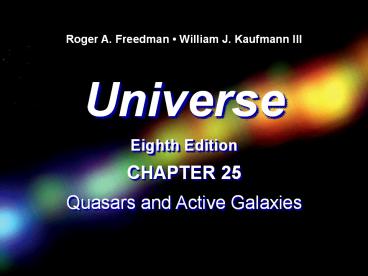Universe 8e Lecture Chapter 25 Quasars and Active Galaxies PowerPoint PPT Presentation
1 / 49
Title: Universe 8e Lecture Chapter 25 Quasars and Active Galaxies
1
Roger A. Freedman William J. Kaufmann III
Universe Eighth Edition
CHAPTER 25 Quasars and Active Galaxies
2
(No Transcript)
3
By reading this chapter, you will learn
- 25-1 The distinctive features of quasars
- 25-2 The connection between quasars and distant
galaxies - 25-3 What Seyfert galaxies and radio galaxies are
and how they compare to quasars - 25-4 The properties of active galactic nuclei
- 25-5 How supermassive black holes can power
active galactic nuclei - 25-6 Why many active galaxies emit ultrafast jets
of material
4
(No Transcript)
5
(No Transcript)
6
(No Transcript)
7
(No Transcript)
8
(No Transcript)
9
(No Transcript)
10
(No Transcript)
11
(No Transcript)
12
(No Transcript)
13
(No Transcript)
14
(No Transcript)
15
(No Transcript)
16
(No Transcript)
17
(No Transcript)
18
(No Transcript)
19
(No Transcript)
20
(No Transcript)
21
(No Transcript)
22
(No Transcript)
23
(No Transcript)
24
(No Transcript)
25
(No Transcript)
26
(No Transcript)
27
(No Transcript)
28
(No Transcript)
29
(No Transcript)
30
(No Transcript)
31
(No Transcript)
32
(No Transcript)
33
(No Transcript)
34
(No Transcript)
35
(No Transcript)
36
(No Transcript)
37
(No Transcript)
38
(No Transcript)
39
(No Transcript)
40
(No Transcript)
41
(No Transcript)
42
(No Transcript)
43
(No Transcript)
44
(No Transcript)
45
(No Transcript)
46
Key Ideas
- Quasars A quasar looks like a star but has a
huge redshift. These redshifts show that quasars
are several hundred megaparsecs or more from the
Earth, according to the Hubble law. - To be seen at such large distances, quasars must
be very luminous, typically about 1000 times
brighter than an ordinary galaxy. - About 10 of all quasars are strong sources of
radio emission and are therefore called
radio-loud the remaining 90 are
radio-quiet. - Some of the energy emitted by quasars is
synchrotron radiation produced by high-speed
particles traveling in a strong magnetic field.
47
Key Ideas
- Seyfert Galaxies Seyfert galaxies are spiral
galaxies with bright nuclei that are strong
sources of radiation. Seyfert galaxies seem to be
nearby, low-luminosity, radio-quiet quasars. - Radio Galaxies Radio galaxies are elliptical
galaxies located midway between the lobes of a
double radio source. - Relativistic particles are ejected from the
nucleus of a radio galaxy along two oppositely
directed beams.
48
Key Ideas
- Blazars Blazars are bright, starlike objects
that can vary rapidly in their luminosity. They
are probably radio galaxies or quasars seen
end-on, with a jet of relativistic particles
aimed toward the Earth. - Active Galaxies Quasars, blazars, and Seyfert
and radio galaxies are examples of active
galaxies. The energy source at the center of an
active galaxy is called an active galactic
nucleus. - Rapid fluctuations in the brightness of active
galaxies indicate that the region that emits
radiation is quite small.
49
Key Ideas
- Black Holes and Active Galactic Nuclei The
preponderance of evidence suggests that an active
galactic nucleus consists of a supermassive black
hole onto which matter accretes. - As gases spiral in toward the supermassive black
hole, some of the gas may be redirected to become
two jets of high-speed particles that are aligned
perpendicularly to the accretion disk. - An observer sees a radio galaxy when the
accretion disk is viewed nearly edge-on, so that
its light is blocked by a surrounding torus. At a
steeper angle, the observer sees a quasar. If one
of the jets is aimed almost directly at the
Earth, a blazar is observed.

